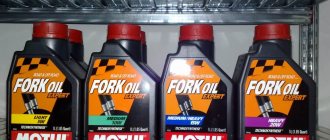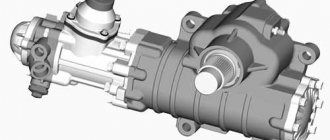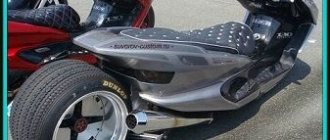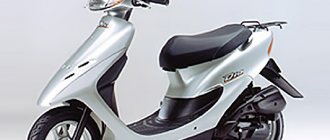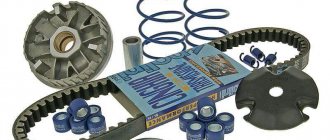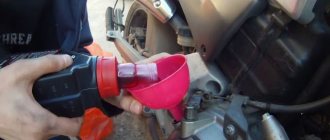Motor oil plays an important role in the engine. The liquid lubricates moving parts, preventing temperature increases at the point of friction. This ensures optimal performance of the power unit, extending its life for many years to come. Oil starvation leads to accelerated wear of engine parts and inevitable breakdown. The four-stroke scooter engine is no exception.
When to change the oil?
The procedure for changing the oil in a four-stroke scooter engine depends on the specific model. Each vehicle has individual characteristics. Some owners can drive up to 5 thousand kilometers and not change the oil, while others have to change it every 2-3 thousand kilometers.
The oil in a new scooter needs to be changed after 300 km. This must be done because break-in lubricant is poured at the factory. It is not recommended to drive on such liquid for a long time. The second replacement should be made after approximately 700 km. Further procedures should be carried out at each technical inspection (approximately once every 3000-4000 km).
The main factors influencing the frequency of oil changes:
- Fuel type and quality;
- Engine capacity;
- Brand of liquid filled;
- Oil condition;
- Replacement method;
- Engine mileage;
- Technical condition of the scooter;
- Method of operation;
- Quality of consumables.
The area in which the scooter is used is suburban or urban.
Oils for winter and summer
To accurately change the oil, you need to use a watering can.
Automotive oils are divided into all-season, summer and winter. They differ in composition. For understanding and the opportunity to purchase exactly what you need, it is marked with Latin letters and numbers. The marking of winter automobile oils must contain the letter “W” (in English, winter). The numbers in the abbreviation indicate viscosity. The higher the indicator, the greater the consistency (viscosity) and, accordingly, vice versa.
Maximum viscousness suitable for use in hot summer periods
You should not pay attention to the letters SAE in the abbreviation. These letters indicate the classification of motor oils, which for scooter owners means nothing other than the viscosity indicator
You need to know that if the oil is marked with SAE letters and numbers, you can safely buy it for pouring into a scooter gearbox in hot weather. If the letter W is present, the oil is suitable for winter.
What oil should I use?
Available types of oils for four-stroke engines: SAE 5W-20 or 10W-40. Depends on the manufacturer. If the vehicle is often operated in high temperature conditions, it is better to choose a motor oil with a high viscosity index.
What to look for when choosing oil? First of all, on the oil indices, which should be present on the canister label. The chemical composition is also no less important. In addition to the index, the exact amount of additives from the fluid manufacturer is used.
For a four-stroke scooter engine, you can use not only oil that is intended for scooters, but also for equipment: walk-behind tractors, lawn mowers, chainsaws and others.
Why is fresh scooter gear oil necessary?
One of the most important components of a scooter can rightly be called the gearbox. It is responsible for timely reducing the speed of the driven shaft, thereby increasing torque. That is, it converts high shaft and clutch speeds into fairly powerful, but low wheel speeds. This part consists of a number of rubbing elements (gears and bearings) that undergo enormous loads, and, as expected, they need good care. It is the transmission oil that provides such care.
It is an oil doped with various functional additives. The main function of transmission fluids can be called protective, as they protect the surface from wear, corrosion, seizing, etc. In addition, thanks to them, energy losses are reduced and heat removal from friction surfaces is ensured. Shock loads, vibrations and noise in gear drives are also significantly reduced.
The process of changing the oil in the engine 139QMB of a 4t scooter
Necessary tools for changing the oil in the engine 139QMB of a 4t scooter:
- 17 or 19 mm socket wrench;
- Capacity with a volume of 1 liter or more;
- Funnel;
- A little gasoline;
- Rags.
Before starting the procedure, you need to warm up the scooter engine. The oil will become highly fluid and will quickly drain from the system. The next sequence of actions is as follows:
- Place the scooter on a flat surface.
- Using a fine metal brush, clean the filler and drain holes. Filler hole location: on the driver's left side, next to the generator flywheel. There are two drain holes. Location: one at the bottom, the other on the left side.
- Open the filler cap. Without air entering the system, the liquid will not drain.
- Unscrew the drain hole nut. It is recommended to unscrew the bottom plug. This will help rinse the metal filter. Please note: there is a spring on the drain plug. Be careful when unscrewing.
- The oil will drain within 5-10 minutes. While it is draining, wash the nut, filter and spring.
- Screw back the nut, filter and spring. Proceed to fill in new lubricant.
- Use a funnel. Fill the engine crankcase with fresh oil. You can safely pour the first 700 ml of oil, but after that, be careful. Different scooters require different volumes of fluid in the engine (from 800 ml to 1000 ml).
- Check the oil level from time to time. If necessary, top up. Do not let the engine starve of oil.
The process of changing the oil in a four-stroke scooter engine is complete!
Changing the oil in engines of various scooters
Changing the oil in other scooters, such as Storm Lzw 500, Honda Tact, Chinese scooter, as well as the 157QMJ engine, is carried out according to a similar scheme. The exception is the location of the drain and fill holes. As a rule, on all scooters these holes are on the left side (determined by the driver's seating position).
A brief process for changing engine oil on other scooter models:
- Warming up the power unit;
- Cleaning the surface around drain and fill plugs. A metal brush is used;
- Drain the old oil into a specially prepared container;
- Cleaning the filter, plug and spring in gasoline;
- Installing components in reverse order;
- Filling with fresh motor oil. Check the level to ensure there is no interruption;
- Start the scooter engine. Let it work. Shut off after five minutes and recheck the level. If necessary, add liquid.
How to make a replacement?
It is better to change this component immediately after the trip. In this state, it is warmed up and will flow out perfectly, which will ensure a minimum residue of old fluid in the gearbox. You should take the brand recommended by the scooter manufacturer. You also need to strictly adhere to the recommended volume.
The required oil volume can be seen on the gearbox.
To replace, place the vehicle level on the main stand. Next, you need to unscrew the drain bolt (if there is one) and wait until all the liquid is drained into a specially prepared container. If there is no such bolt, drainage is carried out through a single bolt. To do this, you need to tilt the scooter on its side. It is worth noting that the oil, which has not been changed for a very long time, has a dark blue color, close to black. But if you notice that the liquid has a metallic color, this means that abrasion has occurred on the working surfaces of the gears. But it’s not so scary, there’s no need to worry. This will not affect the operation of the vehicle in any way. After this, you need to tighten the drain bolt and unscrew the filling hole.
The required volume is most often indicated on the element of the rear gearbox (numbers are stamped). If nothing is specified, carefully read the description of the scooter. Typically, the amount of oil for a scooter whose engine volume does not exceed 50 cm³ is 100 g. You need to take the liquid into a syringe, preferably one with a 20 ml capacity, and pour it into the gearbox. If there is no syringe, oil must be filled to the lower level of the thread of the filler bolt. This is exactly the mark (maximum correct volume). Replacement should only be done with the scooter in an upright position. After the component is poured, the working surface must be wiped with a dry, not dirty cloth and the screw must be tightened.
Consequences of untimely oil changes
The consequences of untimely oil changes in a scooter engine are disappointing.
Possible breakdowns of the scooter:
- The vehicle cannot move;
- Extraneous noise has appeared in the power unit;
- The dynamics have worsened.
All this indicates that the oil in the system has not been changed for a long time. As a result, the channels become clogged, which will also negatively affect the engine components. Component wear is inevitable. Therefore, if the vehicle owner purchased a scooter in maintained condition, the first thing to do is replace the lubricant in the engine.
Preparation
To ensure that all the used oil leaves the engine without any residue, the engine should be thoroughly warmed up before changing the oil. Or, what would be best, start changing the oil immediately after a 5-10 km trip.
The second preparatory stage is that we need to prepare in advance a flat area on which to install the scooter in the most level position possible and prepare a suitable container for used oil.
The tools you use also play an important role. Don't skimp - buy a new head with a knob. You will only need two of them: for 17 and 10. Those who neglect this point pay dearly later, and out of their own pocket.
Scooter gearbox
The job of a scooter gearbox is to transmit rotation from the driven pulley of the variator to the rear wheel. The first gear ratio goes straight through the CVT. The CVT reaches its final ratio (the belt in front goes to the outer radius) by rotating the driven pulley about 5 times per crankshaft rotation (at 10,000 engine rpm, so 50,000 pulley rotations). Presumably, if the wheel were sitting on a driven pulley, then the wheel would have to make 5 full rotations with each ignition (corresponding to the rotation of the crankshaft). The result would be such a long ratio that the motor would not be able to pull. Thus, the importance of the gearbox becomes obvious: by transmitting torque from the driven pulley to the rear wheel, it reduces the rotation speed. How many times? On different scooter models this number may differ slightly, but it is always close to 12, for example on the Yamaha Aerox, to be precise, 12.28, and on the Chinese Baotian Tanco 50 about 11.3. This means that for one revolution of the rear wheel there are 12.28 and 11.3 revolutions of the driven pulley, respectively.
The gearbox gears are located in a closed container at the rear of the scooter housing. The container is filled with oil, so the oil must be drained before opening the lid.
The scooter's gearbox mechanism is divided into primary (gears 1 and 2) and secondary (gears 3 and 4) gears. Primary or secondary gears always consist of two gears - large and small. By dividing the number of teeth on the drive gear by the number of teeth on the driven gear, we obtain the gear ratio. For example, the small and large primary gears (1 and 2) of the Yamaha Aerox have 13 and 52 teeth, respectively. It is clear that the drive in this case is the small gear, so the gear ratio will be equal to 13/52, or 1:4 if we divide the numerator and denominator by 13. For us, this means that for every four revolutions of the drive (small) gear there is only one slave revolution (large). Knowing the sizes of the secondary gears (3 and 4) of the same Yamaha Aerox - 14 and 43 and acting in a similar way, we obtain a ratio of 1: 3.07. Now all that remains is to multiply the resulting ratios 1:4 and 1:3.07 to get the final ratio of the Aerox gearbox 1:12.28 - it was mentioned at the very beginning.
The lower the gear ratio, the longer the transmission. For example (for primary gear), 1:4.2 - short gear; 1:3.15 - medium gear; 1:2.73 - long pass; 1:2.11 - very long pass.
It makes absolutely no difference which gear - primary or secondary - is used to change the final ratio of the gearbox. On scooters prepared for competitions based on High-End piston engines, sometimes even both gears are replaced.
Device
The gearbox is a special device included in the design of any walk-behind tractor. It is this part that is responsible for converting and transmitting torque that is generated from mechanical transmissions. In fact, the gearbox powers the walk-behind tractor, making it work.
The service life of the entire walk-behind tractor, as well as its normal functioning, will depend on its quality, as well as on the correct lubrication of its components.
For more details about the gearbox, watch the video:
Depending on the model of the walk-behind tractor, be it Cayman, Patriot Ural, Patriot, Texas, Foreman or some other, the gearboxes may differ from each other in some design features. Conventionally, gearboxes can be divided into several types:
Angular reducers. Such units are quite effective and allow you to couple the engine and transmission.
- Gear reducers. In this case, the gearbox transmission acts as a kind of intermediary between the engine and the wheelbase of the walk-behind tractor.
- Reduction gearboxes. These units achieve an increase in power indicators by reducing the total number of revolutions. Such gearboxes are most preferable because their design includes an air cooling system, which allows them to operate at maximum loads.
- Reverse gearboxes. The main advantage of such gearboxes is the ability to reverse the walk-behind tractor. However, units equipped with this type of gearbox do not show high performance indicators and speeds.
Regardless of which gearbox is used in the design of the walk-behind tractor, they all consist of almost the same components:
- shaft;
- gear housing;
- flange and its fastening;
- pulley with V-belt drive (or chain);
- ball bearing;
- stars;
- drain plug;
- steel washer and nut;
- input shaft
These components traditionally form the gearbox itself. Their performance and service life will depend on how well they are lubricated.
Gearbox
Otherwise, if there is insufficient lubrication, the parts will wear out greatly, because they come into contact with each other during operation, and the resulting friction negatively affects their surface.
Scooter as one of the main types of urban transport
What kind of oil should you put in your small motorcycle? Any person who has ever owned a scooter in his life and has an interest in having his scooter work faithfully for many years without deteriorating over time should take care of this issue.
Everyone knows that modern scooters can be equipped not only with a two-stroke, but also with a 4-stroke engine. Compared to a 2-stroke scooter engine, the latest scooters do not need to constantly mix gasoline and lubricant on their own. Modern two-stroke scooters have a special system for lubricating the motor, and they also have disc brakes and an electric starter.
However, despite the fact that technology has advanced in recent years, this does not mean that the motor does not need constant care.
Motorcycle maintenance also implies, among everything else, a stable replacement of consumable equipment. And the main thing here is to use high-quality lubricants and oil additives, which are prescribed for motorcycles, but not for automobiles.
What kind of lubricant should be poured into a motorcycle or used in scooters? This question is asked by many owners, and it is also of interest to many schoolchildren who own scooters.
Remember that no technique in this matter can tolerate experimentation.
